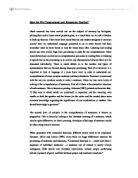Parts of the Brain involved in Memory
Electrical stimulation of exposed temporal lobes in fully conscious patients causes the patient to report vivid experiences of past events. For example, one patient reported hearing a song that they had heard in the past, and on stimulation at the same point, the same melody was heard. Stimulation of the mid-temporal gyrus results in brief retrograde and anterograde amnesia in some patients. Depending on the duration of stimulation, the amnesia lasted from several hours to several days and recovered within 5 minutes to several hours.
Epileptic patients who have undergone bilateral removal of the hippocampus and associated structures exhibit a profound and irreversible deficit of recent memory. New long-term memories could not be formed, but previously acquired long-term memories remained relatively intact e.g. the patient remembered how to talk. Short-term memory was also unaffected, but the transition from short term to long-term memory was virtually absent.
Long Term Potentiation
A brief high frequency train of stimuli to the hippocampus produces an increase in the excitatory synaptic potential in the postsynaptic hippocampal neurons, which can last for days or weeks. This is called long term potentiation (long term potentiation), and in the CA1 regions of the hippocampus it has the following three properties.
-
Cooperativity – more than one fibre must be activated to achieve long term potentiation
-
Associativity – the contributing fibres and the postsynaptic cell need to be active together
-
Specificity – long term potentiation is specific to the active pathway
Activating only one fibre cannot produce long term potentiation; instead, a minimum number of afferent fibres need to be activated. If separate weak and strong excitatory inputs arrive at the same region of the dendrite of a pyramidal cell, the weak input will be potentiated. Induction of long term potentiation in the CA1 region of the hippocampus requires depolarisation of the postsynaptic cell. Long term potentiation is greatly facilitated when postsynaptic inhibition is blocked, and can be reduced or prevented by properly timed action potentials. If the postsynaptic cell is hyperpolarised during the tetanus activity, then long term potentiation is prevented. Long term potentiation can be induced by pairing a weak stimulus train that would not normally cause long term potentiation with a depolarising current injected into a single postsynaptic cell. Therefore, long term potentiation requires depolarisation of the postsynaptic cells accompanying activity in the presynaptic neuron.
Axons from the CA3 region of the hippocampus terminate on the pyramidal cells in the CA1 region using glutamate as their transmitter. Glutamate acts on its target cells by binding to NMDA and non-NMDA receptors, with the non-NMDA receptors dominating in normal synaptic transmission. Normally, Mg2+ blocks the NMDA receptor-channel, but this becomes unblocked and activated when the postsynaptic cell is depolarised by input from many synaptic neurons. Once this channel is unblocked, then it allows the influx of Ca2+ and Na+. The non-NMDA receptor is therefore a voltage and transmitter gated channel, and the blockage can only be removed when glutamate binds to the receptor, and the membrane is depolarised. The depolarisation required is normally achieved by the activation of many non-NMDA receptors due to the firing of many presynaptic neurons. The Ca2+ influx through the unblocked NMDA receptors is critical for long term potentiation, and is thought to be achieved by the persistent enhancement of synaptic transmission by activating two Ca2+ dependant protein kinases (Ca2+/calmodulin kinase, and protein kinase C).
Induction of long term potentiation requires postsynaptic depolarisation (a presynaptic event), but the maintenance of synaptic efficacy in long term potentiation requires an increase in presynaptic transmitter release (a presynaptic event). There must therefore be a message sent from the postsynaptic to the presynaptic neurons. Calcium acting directly, or a calcium activated second messenger system is thought to cause the release of retrograde plasticity factor from the active postsynaptic cell. This then diffuses to the presynaptic terminal to activate a second messenger system that then enhances transmitter release and maintains long term potentiation.
Long Term Potentiation and Spatial Memory
Long term potentiation is involved in many parts of the brain, including the hippocampus, which is known to be important for memory storage. Evidence for long term potentiation being involved in memory storage has come from Morris and his experiments with a swim tank. In this task, a rat has to swim through a water maze filled with an opaque fluid to find a platform hidden under the surface. The animal is released from random positions around the pool, and has to navigate to the pool using spatial cues from in the room around the tank. When long term potentiation receptors in the hippocampus are blocked, the rats can get on to the platform if it is raised above the surface of the fluid, but cannot find the platform if it below the surface. This suggests that an NMDA receptor mechanism, possibly long term potentiation, is involved in spatial learning.







